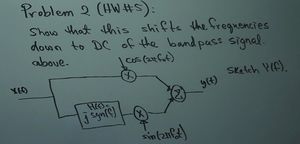Signals and Systems: Difference between revisions
Jump to navigation
Jump to search
No edit summary |
|||
| Line 57: | Line 57: | ||
[[FIR Filter Example Code for Octave]] |
[[FIR Filter Example Code for Octave]] |
||
[[Leakage Example Octave Script]] |
|||
[[Interpolation using the DFT Example Script]] |
|||
===[[Table of Fourier Transform Properties]]=== |
===[[Table of Fourier Transform Properties]]=== |
||
Revision as of 15:35, 15 November 2010
Topics
Overview of Signals and Systems
Individual Subjects
- Linear Time Invariant Systems
- Orthogonal Functions
- Finding the Energy in a Signal
- Fourier Series
- Fourier Transforms
- Sampling
- FIR Filter Example
- Relationship between e, sin and cos
Some Useful Links to Suppliment or Substitute for a Textbook
Books on Signal Processing
Fourier Series
- Interactive Mathematics (like a textbook with some examples)
- Mathworld
- Wikipedia
- MIT handout on Fourier Series, Fourier Transform, and Laplace Transform
- Fourier Theory B..M..N.. Clarke
Dirac Delta Function and Convolution
Multi-rate Filtering
Multirate Filters Introduction
Slides from a Presentation on Polyphase Decimation and Interpolation by Mark Fowler
Course Pages
Class notes for Signals & Systems
Articles
Octave Tutorials
Installing Octave on a Mac (Chris Lau)
Octave and Scilab on a Mac (Ben Henry)
ASN2 - Octave Tutorial (Jodi S. Hodge)
FIR Filter Example Code for Octave
Interpolation using the DFT Example Script
Table of Fourier Transform Properties
Homework Assignments
Please put your name next to the assignment, linking it to your submission
- HW #1 - Make a personal page on this wiki (Chris Lau)(Jodi S. Hodge)(Chris Wills)
- HW #2 - Write a tutorial about installing and/or using Octave (Chris Lau)(Jodi S. Hodge)(Victor Shepherd)
- HW #3 - Show graphically that (Chris Lau)(Jodi S. Hodge)(Chris Wills)(Victor Shepherd)
- HW #4 - Given a linear time-invariant system where produces an output , find the output due to any function (Chris Lau)
- HW #5: (Chris Lau)
- Part 1 - Find and relate it to the Laplace Transform. Derive the Inverse Laplace Transform of this from the inverse Fourier Transform.
- Part 2 -
- HW #6 - Pick a property of the Fourier Transform & present it on the Wiki. Make a table with all your properties. Interpret your property. (Ben Henry)(Chris Lau)
- HW #7 - Finish the practice tests
- HW #8 - Make a page about interpolating FIR filters. Note how many multiply/add operations.(Jodi S. Hodge)
- HW #9 - Add to #8 writeup how to do a decimating filter and figure out how many multiply & adds are needed for a n/2 decimating low pass filter.(Jodi S. Hodge)
- HW #10 - Use Octave (or Mathlab or Silab) to plot the frequency response of low pass filters with cut off frequencies of 1/32T, 1/8T, and 1/4T and compare how many coeffficients are needed with an eye to answer the question "Is it less calculation to decimate and then filter, or better to put the filter in the pre-decimation filter?" (Jodi S. Hodge)
- HW #11 - Is our method the same as Mark Flower's? See
Wiki. Same # multiply and adds? See Notes 11/3/10. (Jodi S. Hodge)




![{\displaystyle {\mathcal {F}}[e^{-\sigma t}x(t)u(t)]}](https://wikimedia.org/api/rest_v1/media/math/render/svg/fff13c3c7a479f107c9e90e0aed1908dd4a969ce)
